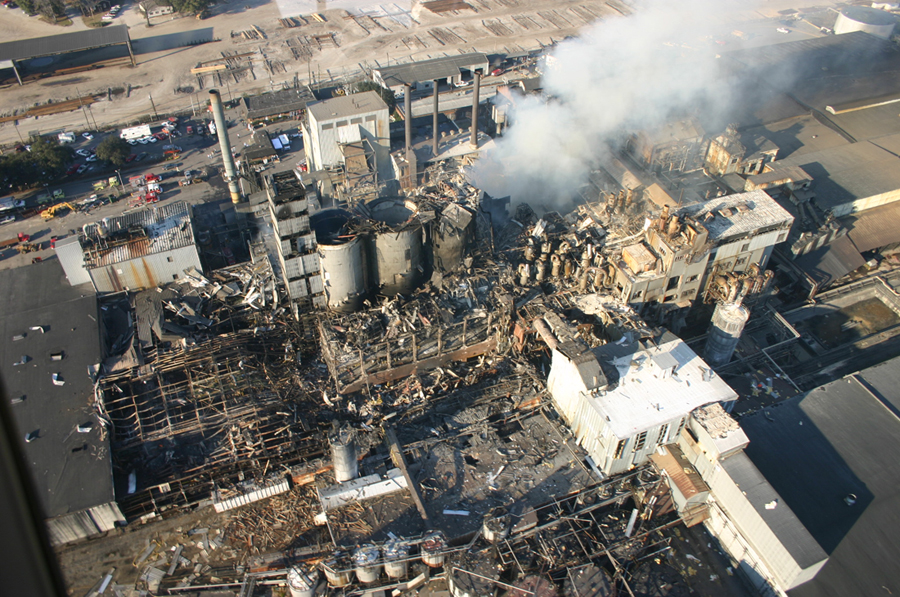Caution: going to work may still be dangerous to your health
1979
A closely divided Supreme Court strikes down OSHA regulation designed to limit airborne exposure to benzene, a carcinogen thought to cause leukemia. There is no majority opinion, but a plurality of three justices concludes that OSHA must demonstrate that there is “a significant risk of harm” from current exposure limits in order to pass a standard, and that it had failed to do so. Four justices dissent, writing that the plurality opinion “ignores the plain meaning” of the Occupational Safety and Health Act and “places the burden squarely on the shoulders of the American worker.” According to the dissent, the plurality opinion ignored a key section of the statute that provides that the standard to be set is the one “which most adequately assures, to the extent feasible, on the basis of the best available evidence, that no employee will suffer material impairment of health or functional capacity even if such employee has regular exposure to the hazard dealt with by such standard for the period of his working life.” (The dissent further observed that, contrary to the plurality, “In its ordinary meaning an activity is ‘feasible’ if it is capable of achievement, not if its benefits outweigh its costs.”)
— Washington representative of the Oil, Chemical & Atomic Workers International Union, 1976
Industry lawyer Charles Lettow says that if the regulation had not been invalidated, the standards banning skin contact with liquids containing benzene would have shut down the rubber tire industry entirely.[2]
Richard Carelli, Untitled, Associated Press, October 10, 1979, accessed September 20, 2011, Nexis.com.
March 1980
Congress passes the Regulatory Flexibility Act, which establishes the Office of Budget and Regulatory Affairs (a sector of the Office of Management and Budget). This new office is tasked with making sure that all proposed rules have met all requirements of the rule-making process outlined in the Act. Among these requirements, agencies must “solicit and consider flexible regulatory proposals and explain the rationale for their actions to assure that such proposals are given serious consideration.” The office has the authority to advise the agency to either withdraw or finalize a rule.
When the Small Business Administration is created, Chief Counsel of the Office of Advocacy Frank Swain says, “He adds that regulatory reformers will try to “purge the arrogant, inflexible attitudes” from the ranks of the bureaucracy.”[3]
Frank Swain, “Small Business’s Turn for Relief from Red Tape,” U.S. News and World Report, October 12, 1981, accessed September 29, 2010, Nexis.com.
October 1980
An Associated Press article reports that “regulators take a rhetorical beating,” with both 1980 presidential candidates campaigning as deregulators. Each draws upon and reinforces the assumption that regulation hurts business. Ronald Reagan, for instance, is reported to be campaigning on the theme that the regulations promulgated under the Carter administration hurt businesses, farmers, and workers.
Credit: Chemical Safety Board; Public Domain
President Carter, on the other hand, is reported to be arguing that he has done more for deregulation than any other president. Carter has asserted that deregulation — including in the area of worker safety — has allowed industries to operate more efficiently and that consumers have as a result had billions of dollars of savings passed along to them every year. Reagan counters by saying that Carter’s actions are only “highly publicized examples of showcase deregulation where Mr. Carter has acceded to congressional demands to deregulate.”
Consistent with previous policy preferences — for instance, that OSHA be limited to an advisory role and that either house of Congress be permitted to veto OSHA regulations — Reagan says the he will eliminate what he calls unnecessary regulations that hamper the economy.[4] He also claims, despite his previous call to limit OSHA to an advisory role, that he will work to reform OSHA to strengthen its ability to reduce job-related accidents. After the election, Reagan’s aides say that Reagan will propose cuts to the budget and staff of OSHA while also ordering it to scale back on investigations.[5]
Jeffery Mills, “In a Campaign Year, Regulators Take a Rhetorical Beating,” Associated Press, October 24, 1980, accessed September 20, 2011, Nexis.com.
Merril Sheils with Mary Hager and William J. Cook, “Reagan’s Big Cleanup Fight,” Newsweek, December 8, 1980, accessed September 28, 2011, Nexis.com.
1981
Supreme Court, in a case involving regulation of cotton dust, rejects argument that OSHA is required by its enabling statute to conduct cost-benefit analyses, ruling instead that the agency must evaluate whether a proposed rule would threaten the economic vitality of an industry. Despite the ruling, other developments result as a practical matter in time-consuming analyses of costs and benefits being conducted over the ensuing decades. These developments include the impact of the Regulatory Flexibility Act and later Congressional enactments, executive branch direction to OSHA, and inter-agency policy and philosophy.
1982
Sierra Club publishes report called “Poisons on the Job: The Reagan Administration and American Workers,” which finds that 10 million workers are exposed to cancer-causing substances each day and that 100,000 will die yearly from this exposure. The report blames the Reagan administration for not creating new standards on chemical exposure and for weak enforcement of the existing but inadequate regulations. Reagan administration calls report “hogwash.”

